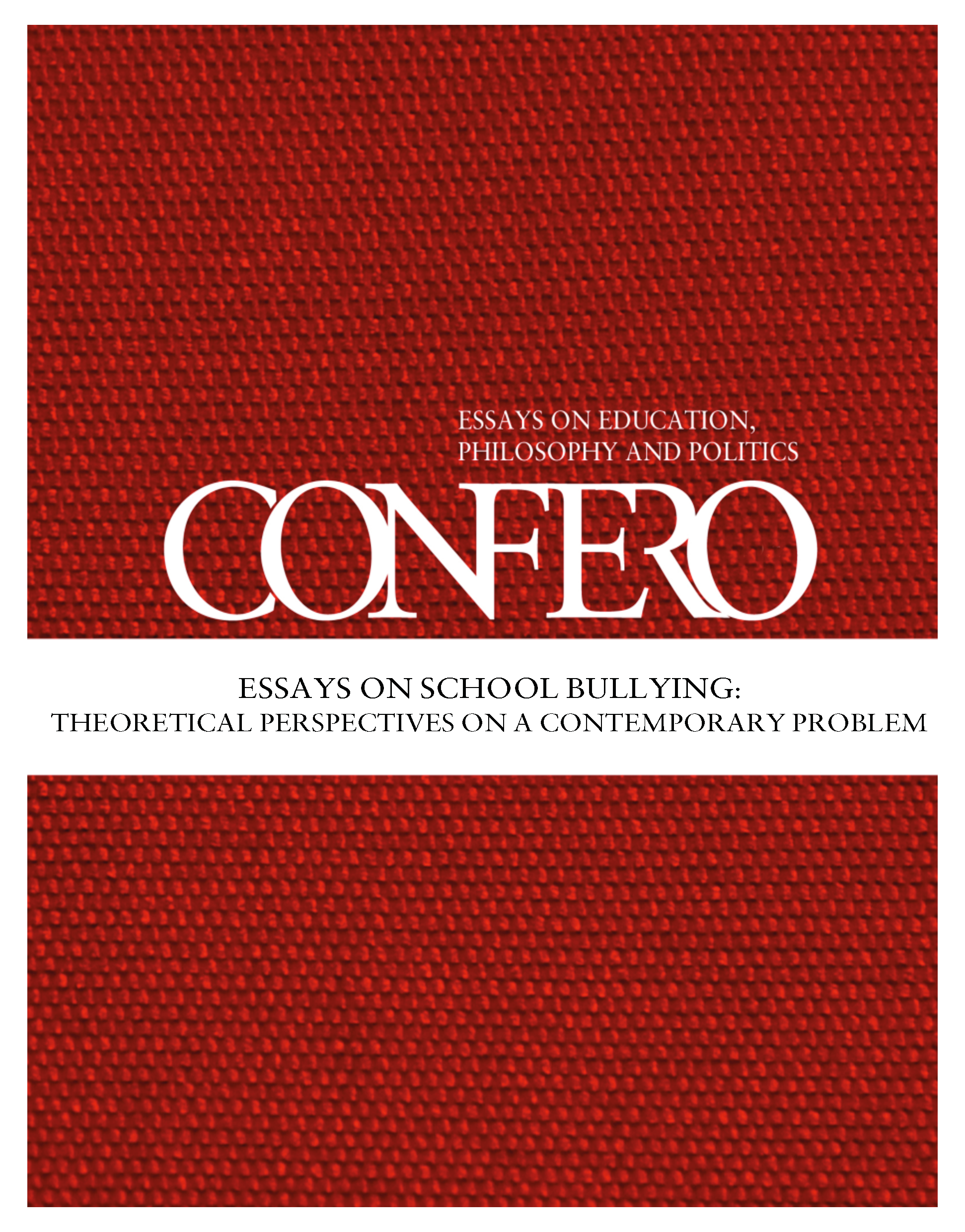Essays on school bullying
Theoretical perspectives on a contemporary problem
DOI:
https://doi.org/10.3384/confero.2001-4562.1501988Abstract
Not Available.
References
Burk, Fredrik L. “Teasing and bullying.” Pedagogical Seminary 4 (1897): 336-371. DOI: 10.1080/08919402.1897.10534145
Dale, R. R. Mixed or Single Sex School? Vol. II: Some Social Aspects. London: Routledge and Kegan Paul, 1971.
Duncan, Neil. Sexual Bullying: Gender Conflict and Pupil Culture in Secondary Schools. London: Routledge, 1999.
Gutteridge, Nick. “EXCLUSIVE: More than six in 10 people bullied at school according to Express.co.uk poll.” Express 17 July 2015.
George, Martin. “Annual survey reveals surge in cyber-bullying inside our schools.” Eastern Daily Press 3 August 2015.
Heinemann, Peter-Paul. Mobbning – Gruppvåld bland barn och vuxna. Stockholm: Natur och Kultur, 1972.
Horton, Paul. “Portraying monsters: framing school bullying through a macro lens.” Discourse: Studies in the Cultural Politics of Education (2014) DOI: 10.1080/01596306.2014.951833
Hughes, Thomas. Tom Brown’s schooldays and Tom Brown at Oxford. Ware: Wordsworth. 1857/2007.
Jimerson, Shane, and Huai, Nan. “International perspectives on bullying prevention and intervention.” Handbook of Bullying in Schools: An International Perspective. Eds. Shane R. Jimerson, Susan M. Swearer, and Dorothy L. Espelage. New York: Routledge, 2010. 571-592.
Laslett, Robert. “Disruptive and violent pupils: the facts and fallacies.” Educational Review 29 (1977): 152-162. DOI: 10.1080/0013191770290302
Lowenstein, Ludwig F. “Who is the bully?” Home and School 11 (1977): 3-4.
Nylander, Erik, Aman, Robert, Hallqvist, Anders, Malmquist, Anna, and Sandberg, Fredrik. “Managing by measuring: Academic knowledge production under the ranks.” Confero: Essays on Education, Philosophy and Politics 1.1 (2013): 5-18.
Ohsako, Toshio. Violence at School: Global Issues and Interventions. Paris: UNESCO, 1997.
Olweus, Dan. Hackkycklingar och översittare. Forskning om skolmobbning. Stockholm: Almqvist och Wicksell, 1973.
Olweus, Dan. Bullying at school: What we know and what we can do. Malden, MA: Blackwell, 1993.
Rivers, Ian, and Duncan, Neil. Bullying: Experiences and discourses of sexuality and gender. London and New York: Routledge, 2013.
Roland, Erling. “The Scandinavian research tradition.” Bullying in Schools. Eds. Delwyn P. Tattum and David A. Lane. Stoke-on-Trent: Trentham Books, 1989. 21-32.
Schott, Robin M. and Søndergaard, Dorte M. School Bullying: New Theories in Context. Cambridge: Cambridge University Press. 2014. DOI: 10.1017/CBO9781139226707
Sittichai, Ruthaychonnee, and Smith, Peter K. “Bullying in South-East Asian countries: A review.” Aggression and Violent Behavior (2015) DOI: 10.1016/j.avb.2015.06.002
Smith, Peter K. Understanding School Bullying: Its Nature and Prevention Strategies. London: Sage, 2014.
Taki, Mitsuru. “Relation among bullying, stress and stressor: A follow-up survey using panel data and a comparative survey between Japan and Australia. Japanese Society 5 (2001): 25-40.
Walton, Gerald. “‘Bullying Widespread’: A critical analysis of research and public discourse on bullying.” Journal of School Violence 4.1 (2005): 91-118.
Walton, Gerald. “Spinning our wheels: reconceptualizing bullying beyond behaviour-focused approaches.” Discourse: Studies in the Cultural Politics of Education 32.1 (2011): 131-144. DOI: 10.1080/01596306.2011.537079
Yoneyama, Shoko. The Japanese High School: Silence and Resistance. London: Routledge, 1999.
Yoneyama, Shoko, and Naito, Asao. “Problems with the paradigm: The school as a factor in understanding bullying (with special reference to Japan).” British Journal of Sociology of Education 24 (2003): 315-330. DOI: 10.1080/01425690301894
Sennett, R. (1998). The Corrosion of Character. New York/London: Norton.
Downloads
Published
Issue
Section
License
Copyright (c) 2015 Paul Horton, Camilla Forsberg

This work is licensed under a Creative Commons Attribution 4.0 International License.
As Confero is an open access journal, this means that anyone who can access the Internet can freely download and read the journal. There are no commercial interests for Linköping University Electronic Press or Confero in publishing the journal.
The core idea of open access is that copyright remains with the author(s). However, we publish with the agreement of the author that if she or he decides later to publish the article elsewhere, that the publisher will be notified, prior to any acceptance, that the article has already been published by Confero.
When publishing with Confero, it is with the agreement of the author that if they make their article available elsewhere on the internet (for example, on their own website or an institutional website), that they will do so by making a link to the article as published in Confero using the Digital Object Identifier (DOI) number of the article and acknowledge in the text of the site that the article has been previously published in Confero.
As evident by the markers on our homepage, Confero falls under the Creative Commons licence abbreviated BY. This means that we allow others to use, spread and elaborate on the published articles, as long as they acknowledge who published it and where it was originally published.



